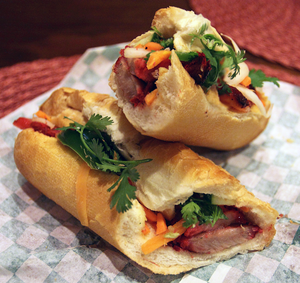famous Vietnamese foods details - banh mi be bi
In vietnamese delicacies, bánh mì or banh mi is a brief baguette with skinny, crisp crust and tender, ethereal texture. It is regularly break up lengthwise and packed with savory components like a submarine sandwich and served as a meal, banh mi be bi referred to as bánh mì thịt. Undeniable banh mi is likewise eaten as a staple meals. A regular vietnamese roll or sandwich is a fusion of meats and veggies from native vietnamese delicacies such as chả lụa (beef sausage), coriander leaf (cilantro), cucumber, pickled carrots, and pickled daikon combined with condiments from french cuisine inclusive of pâté, at the side of crimson chili and buttery mayonnaise.
however, a huge variety of famous fillings are used, from xíu mại (a chinese language delicacies) to even ice cream. In vietnam, bread rolls and sandwiches are usually eaten for breakfast or as a snack. The baguette was added to vietnam by using the french within the mid-nineteenth century, at some point of the nguyễn dynasty, and became a staple food by the early 20th century. In the 1950s, a enormously vietnamese fashion of sandwich advanced in saigon, becoming a famous street food, additionally referred to as bánh mì sài gòn ("saigon sandwich", "saigon-style banh mi").following the vietnam warfare, remote places vietnamese popularized the bánh mì sandwich in nations along with australia, canada and the usa. In those international locations they may be commonly bought in asian bakeries.
in vietnamese, the phrase bánh mì is derived from bánh (that can seek advice from many kinds of food, more often than not baked goods, which include bread) and mì (wheat). It is able to additionally be spelled bánh mỳ in northern vietnam. Taken alone, bánh mì approach any sort of bread, however it may seek advice from the vietnamese baguette, or the sandwich crafted from it. To distinguish the un-crammed bread from the sandwich with fillings, the term bánh mì không ("plain bread") may be used. To differentiate the vietnamese-fashion bread from other sorts of bread, the time period bánh mì sài gòn ("saigon-fashion bread") or bánh mì việt nam ("vietnam-fashion bread") can be used.
the word bánh mì, meaning "bread", is attested in vietnamese as early as the 1830s, in jean-louis taberd's dictionary dictionarium latino-annamiticum the french delivered vietnam to the baguette, along side different baked goods inclusive of pâté chaud, within the 1860s, at the start in their imperialism in vietnam. northern vietnamese first of all referred to as the baguette bánh tây, actually "western bánh", at the same time as southern vietnamese called it bánh mì, nguyễn Đình chiểu mentions the baguette in his 1861 poem "văn tế nghĩa sĩ cần giuộc".
Due to the charge of imported wheat at the time, french baguettes and sandwiches had been taken into consideration a luxury. At some stage in global struggle i, an inflow of french soldiers and elements arrived. At the equal time, disruptions of wheat imports led bakers to begin blending in inexpensive rice flour (which also made the bread fluffier). As a end result, it have become viable for everyday vietnamese to enjoy french staples which include bread. many stores baked twice an afternoon, due to the fact bread has a tendency to head stale greater fast inside the vietnamese weather. Baguettes were specifically eaten for breakfast with a few butter and sugar. discover more

.jpg)
.jpg)
Comments
Post a Comment